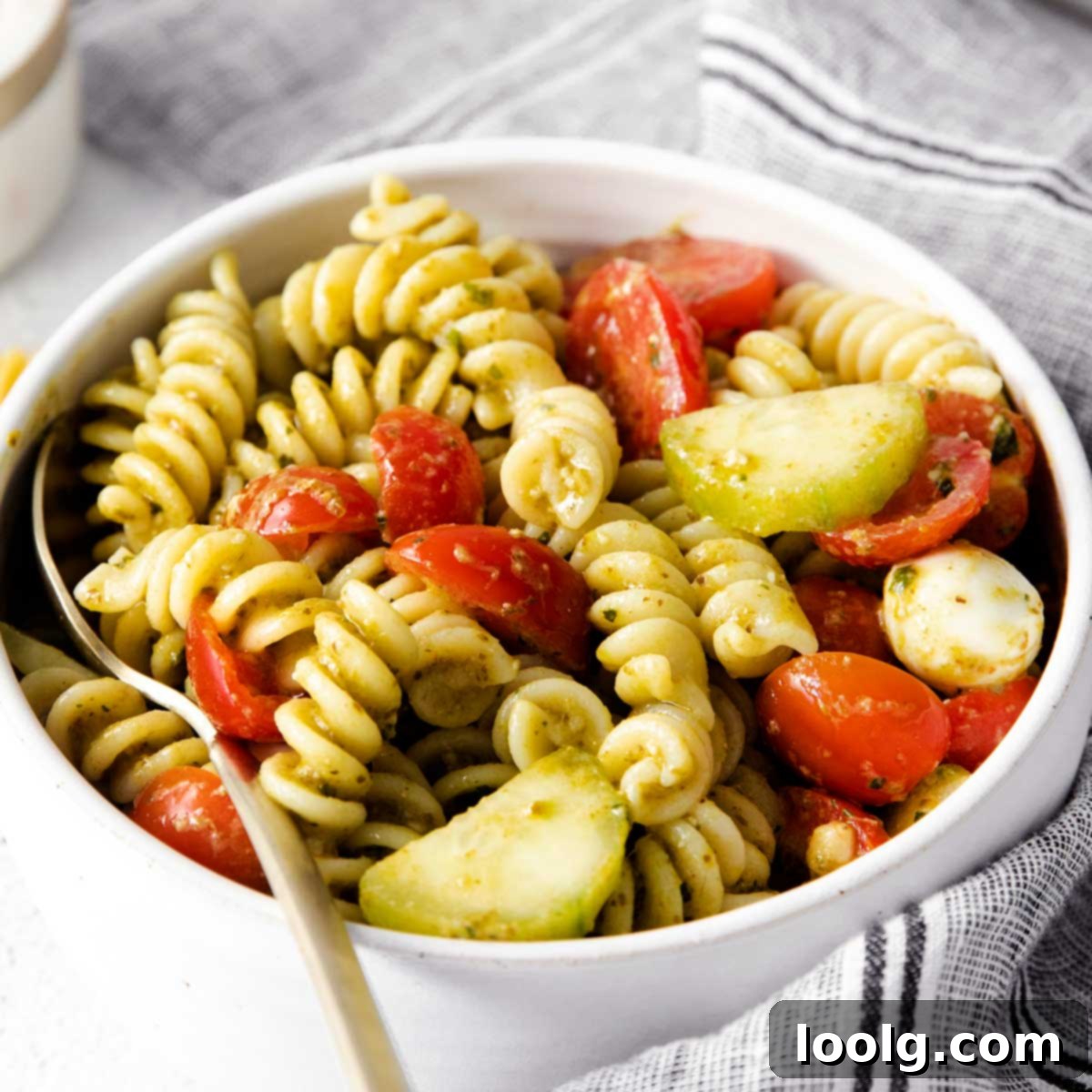Effortless Summer Pesto Pasta Salad: A Fresh & Wholesome Recipe for Any Occasion
Welcome to the quintessential summer dish! This delightful Summer Pesto Pasta Salad is more than just a meal; it’s a celebration of fresh flavors and effortless cooking. Perfect for busy weeknights when you crave something light yet satisfying, or for adding a vibrant, wholesome touch to your Sunday picnics and potlucks. Imagine tender pasta generously coated in a luscious, homemade (or high-quality store-bought) basil pesto, mingling with crunchy toasted pine nuts, pungent garlic, creamy mozzarella pearls, and bursting sweet cherry tomatoes, all uplifted by crisp cucumber slices. This vibrant medley is a feast for both the eyes and the palate, delivering freshness in every bite.
As the temperatures rise, my kitchen philosophy shifts towards quick, simple, and refreshing dishes. That’s precisely why this pesto pasta salad has become a seasonal favorite! Much like my beloved Greek Pasta Salad, it allows me to whip up a healthy, hearty meal in under 20 minutes, leaving more time to enjoy the beautiful summer days.
What truly sets this salad apart is its incredible taste and stunning presentation. Loaded with an array of colorful tomatoes and those irresistible little mozzarella pearls, it looks far more intricate than it is to prepare. It’s a dish that consistently impresses with its simplicity and bursts of Mediterranean-inspired flavors.
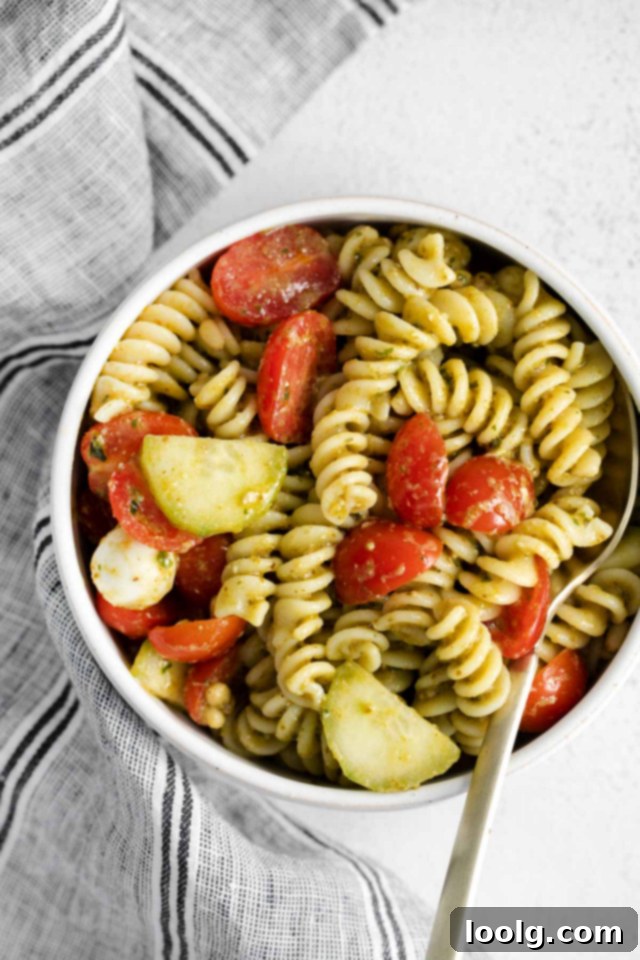
Crafting Your Perfect Pesto Pasta Salad: Essential Ingredients
The beauty of this pesto pasta salad lies in its vibrant, fresh ingredients. Each component plays a crucial role in building the dish’s irresistible texture and flavor profile. Here’s what you’ll need to bring this summer sensation to life:
- Fusilli Pasta: These spiral-shaped noodles are ideal as their grooves perfectly capture and hold the rich pesto sauce, ensuring a burst of flavor in every forkful. However, feel free to explore other pasta shapes (more on that below!).
- Pesto: The heart of the dish! Whether you opt for a homemade basil pesto or a high-quality store-bought variety, its fresh, herbaceous flavor is non-negotiable.
- Cherry Tomatoes: Halved cherry tomatoes add a delightful sweetness and a juicy pop, contrasting beautifully with the creamy cheese and savory pesto. Their bright red hue also contributes to the salad’s visual appeal.
- Mini Mozzarella Balls (Pearls): These tiny, tender balls of fresh mozzarella introduce a creamy, milky texture and a mild, refreshing flavor. They’re soft, easy to eat, and visually appealing.
- Cucumber: Crisp, cool cucumber slices add a refreshing crunch and a subtle, clean flavor that balances the richness of the pesto and cheese. English cucumbers are great as they don’t require peeling.
- Toasted Pine Nuts: A small but mighty ingredient! Toasted pine nuts provide a buttery, nutty depth of flavor and a satisfying textural contrast. Don’t skip the toasting step for the best results!
- Salt and Pepper: To taste, these basic seasonings are essential for enhancing all the natural flavors and bringing everything into perfect harmony.
Whipping Up Your Summer Pesto Pasta Salad: A Simple Guide
Making this incredible pasta salad is surprisingly straightforward, even for novice cooks. Follow these easy steps to create a dish that’s sure to become a summer staple:
- Cook the Pasta: Bring a large pot of salted water to a rolling boil. Add your fusilli (or chosen pasta shape) and cook according to package directions until al dente. This typically means it’s tender but still has a slight bite.
- Reserve Pasta Water & Rinse: Before draining, scoop out about 1 cup of the starchy pasta water. This “liquid gold” is crucial for achieving the perfect pesto consistency. Then, drain the remaining pasta and rinse it thoroughly under cool water. Rinsing immediately stops the cooking process, ensuring your pasta stays al dente and prevents it from becoming mushy, which is especially important for a cold pasta salad.
- Whisk Pesto and Pasta Water: In a large mixing bowl, combine about ¼ cup of the reserved pasta water with your pesto. Whisk them together until you have a smooth, slightly thinner pesto sauce. This step helps the pesto coat the pasta more evenly and adds a silky texture without making the salad oily.
- Combine Ingredients: Add the cooled, rinsed pasta, halved cherry tomatoes, mini mozzarella pearls, crisp cucumber slices, and toasted pine nuts to the bowl with the pesto mixture.
- Toss and Coat: Gently toss all the ingredients together until the pasta and vegetables are uniformly coated in the vibrant pesto sauce. Ensure everything is well combined for an even distribution of flavor.
- Season to Perfection: Taste the salad and season generously with salt and freshly ground black pepper to your preference. Adjust as needed.
- Garnish (Optional): For an extra touch of freshness and visual appeal, garnish your finished pasta salad with a few fresh basil leaves before serving.
- Serve and Enjoy: This salad is best served chilled or at room temperature. For optimal flavor melding, allow it to sit in the fridge for at least 30 minutes before serving.
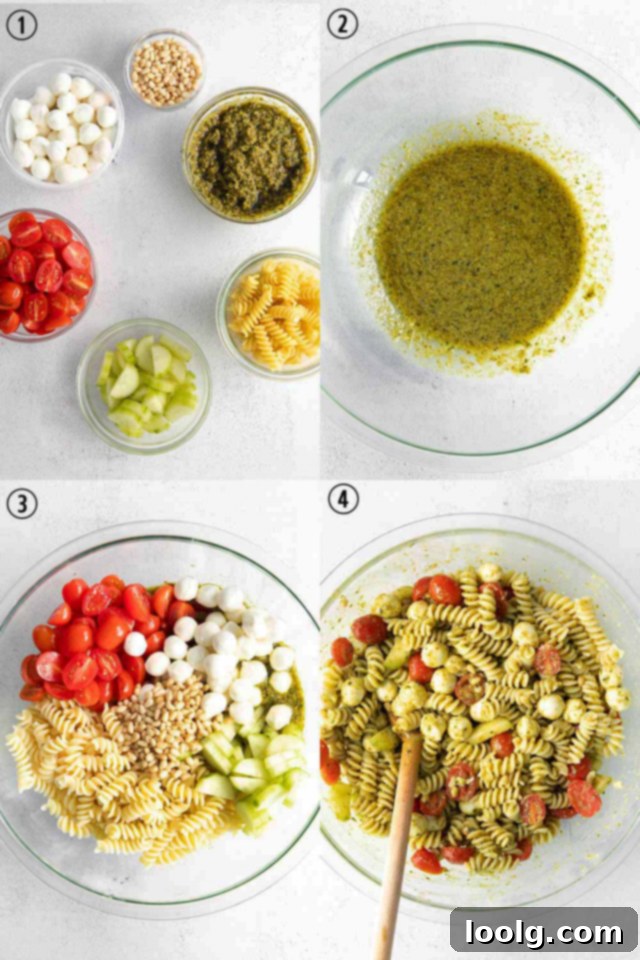
Recipe Notes for an Exceptional Pesto Pasta Salad
- Quality Ingredients Matter: The success of any simple dish hinges on the quality of its components. This is especially true for pesto pasta salad. If using store-bought pesto, invest in the best-tasting brand you can find. If you’re making your own, prioritize the freshest basil, high-quality Parmesan, and fragrant extra virgin olive oil.
- Perfectly Cooked Pasta: Rinsing your pasta under cool water after cooking is a crucial step for cold pasta salads. It immediately halts the cooking process, preventing the pasta from becoming overcooked and mushy. This ensures your pasta remains perfectly al dente, offering that desired textural bite.
- Toasting Pine Nuts: While optional, toasting pine nuts is highly recommended. This simple step deepens their rich, creamy flavor and adds an aromatic complexity that elevates the entire dish. Texanerin Baking offers an excellent guide on how to toast pine nuts using four quick and easy methods.
- Cucumber Choices: If you’re using an English cucumber, there’s no need to peel it! Its skin is thin and tender, adding extra color and nutrients to your salad. For other cucumber varieties, peeling might be preferred for a smoother texture.
- Pasta Shape Flexibility: Don’t feel confined to fusilli. While it’s a great choice, feel free to use any pasta shape you prefer. The key is to choose a shape that can effectively hold the pesto sauce.
- Make Ahead Tip: This salad can be made ahead of time, which is fantastic for parties or meal prep. The flavors meld beautifully as it chills. Just be sure to store it in an airtight container in the refrigerator.
Homemade Pesto vs. Store-Bought: Which to Choose?
The choice between homemade and store-bought pesto is a common dilemma, and ultimately, it comes down to personal preference and available time. Both options can yield a delicious pasta salad.
When time is of the essence, a good quality store-bought pesto can be a lifesaver. It offers convenience without compromising too much on flavor. Look for brands that list fresh basil, Parmesan cheese, pine nuts, garlic, and olive oil as primary ingredients and avoid those with excessive preservatives or artificial flavors. A quick glance at the ingredient list will tell you a lot about the quality.
However, if you have a few extra minutes and access to fresh ingredients, making pesto from scratch is an incredibly rewarding experience. It’s surprisingly easy to do in a food processor – simply combine fresh basil leaves, garlic, pine nuts, Parmesan cheese, and a good quality extra virgin olive oil, then blend until smooth. The aroma and vibrant flavor of homemade pesto are unmatched. Fresh basil is most abundant during the summer months, making it the perfect time to create your own homemade pesto for this delightful pasta salad. Even in colder months, you can often find fresh basil or even grow it indoors.
Having a batch of homemade pesto on hand is also incredibly versatile. You could easily add it to dishes like Air Fryer Frozen Chicken Breast for a quick and flavorful weeknight dinner, demonstrating how a little effort can go a long way.
Delicious Variations and Creative Add-ons for Your Pesto Pasta Salad
This summer pesto pasta salad is incredibly versatile, making it easy to customize and truly make your own. Don’t hesitate to experiment with different ingredients to suit your taste preferences or what you have on hand.
Cheese Alternatives: If mozzarella isn’t your favorite, or if you simply want to explore other flavors, there are many fantastic cheese options. For a sharper, saltier kick, try crumbled feta cheese. To add a distinct Italian flair, consider using shaved Asiago, finely grated Pecorino Romano for a peppery note, or mild Grana Padano. Each cheese will bring its unique character to the salad.
Vegetable Enhancements: Boost the vegetable content and flavor by adding other summer produce. Chopped bell peppers (red, yellow, or orange) offer sweetness and crunch. Black olives or Kalamata olives can introduce a briny, Mediterranean twist. For a Sicilian touch, sun-dried tomatoes (either oil-packed or rehydrated) add a concentrated, intense tomato flavor. Roasted red peppers are another excellent addition for a smoky sweetness.
Adding Protein: Transform this side dish into a hearty main course by incorporating your favorite protein. Leftover chopped grilled chicken or rotisserie chicken turns it into a satisfying chicken pesto pasta salad. Cooked shrimp or grilled salmon flakes would also be excellent seafood options. For a vegetarian protein boost, consider adding chickpeas, white beans, or even some cooked and crumbled plant-based sausage. This Chicken Pesto Pasta recipe also looks like a great source of inspiration!
Exploring Different Pesto Flavors: While classic basil pesto is fantastic, don’t limit yourself! The world of pesto is vast and delicious. If you’re feeling adventurous, try one of these alternative pesto recipes:
- Avocado Pesto: Offers a creamier texture and milder flavor.
- Spinach Pesto: A milder, nutrient-rich alternative that’s great for those who prefer less basil intensity.
- Green Pea Pesto: Surprisingly sweet and vibrant, an excellent way to incorporate more legumes.
- Nut-free Garlic Scape Pesto: A unique, pungent option for those with nut allergies or who enjoy strong garlic flavor.
Choosing the Right Pasta Shape: Beyond Fusilli
While fusilli (or rotini) is my personal favorite for this dish due to its charming spirals that expertly cling to the pesto, you are by no means restricted to it. The “right” pasta shape often comes down to personal preference and what you have in your pantry. The key is to select a textured pasta that allows the vibrant pesto sauce to adhere well, ensuring flavor in every bite.
Here are a few excellent alternatives that work wonderfully in cold pasta salads:
- Penne: A classic choice, its tubular shape and ridged surface are perfect for trapping sauces. It’s readily available and makes for satisfying bite-sized pieces.
- Orecchiette: Meaning “little ears,” these concave pasta shells are fantastic at scooping up and holding dollops of pesto and other small ingredients like mozzarella pearls.
- Farfalle (Bow Ties): These whimsical shapes offer a pleasant chew and pockets for the sauce. They also add a fun visual element to the salad.
- Conchiglie (Shells): Similar to orecchiette, small shells are excellent sauce-holders and provide a lovely texture.
- Trofie: A lesser-known but historically significant option, Trofie is a short, twisted pasta originating from Liguria, Italy – the very birthplace of basil pesto. If you can find it, it’s an authentic and excellent choice that pairs perfectly with its regional sauce.
While long, ribbon-like pasta such as linguine is suitable for warm pesto dishes, for a cold pasta salad, I generally opt for shorter, more bite-sized pasta shapes. They are easier to manage and serve, making the salad more enjoyable to eat.
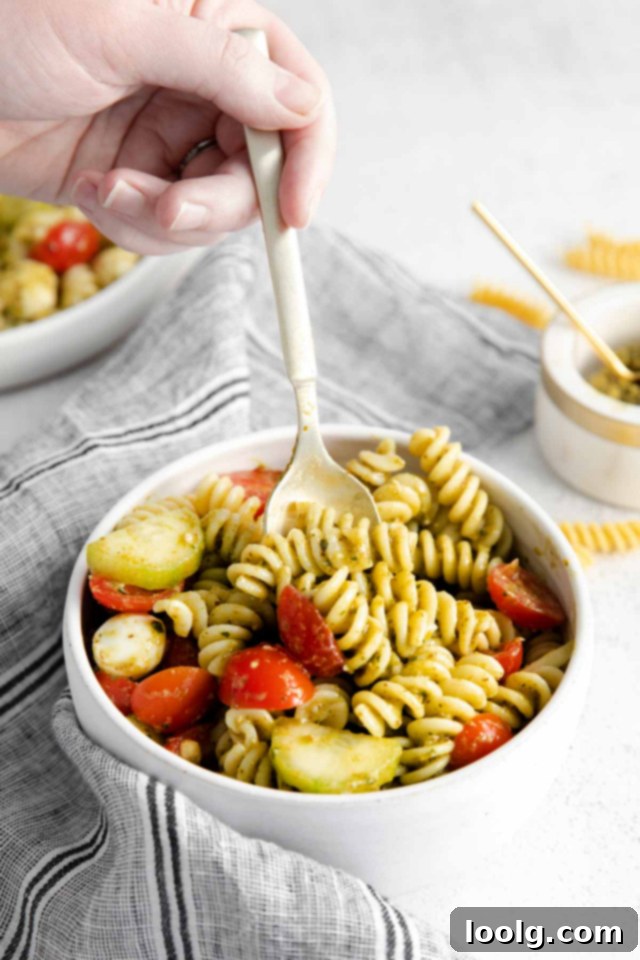
Beyond Basil: Exploring Alternative Herbs for Your Pesto
While basil is the undisputed star of classic Italian pesto, the world of herbs offers exciting opportunities to customize your pesto and pasta salad experience. You absolutely can use other herbs, either by themselves or mixed with basil, to create unique flavor profiles.
Leafy Green Alternatives: These greens make excellent bases for pesto, often providing a slightly different texture and nutritional boost:
- Kale Pesto: Offers an earthy, slightly bitter note, packed with nutrients. Blanching the kale before blending can soften its texture and mellow its flavor.
- Arugula Pesto: Delivers a peppery, slightly spicy kick that adds an exciting edge to the salad.
- Spinach Pesto: A milder, sweeter alternative to basil, perfect for those who prefer a less intense herbal flavor or for sneaking in extra greens.
Aromatic Herb Mix-ins: For a more complex flavor, consider combining leafy greens with smaller amounts of aromatic herbs:
- Parsley: Fresh, bright, and slightly peppery, parsley makes a fantastic addition or substitute, especially flat-leaf Italian parsley.
- Cilantro: If you love its distinctive flavor, cilantro can create a vibrant, zesty pesto with a Mexican or Asian twist.
- Oregano: A small amount of fresh oregano can add a robust, Mediterranean depth, but use sparingly as its flavor is strong.
- Chives: Offer a delicate oniony flavor without the sharpness of raw garlic.
- Thyme: Earthy and aromatic, a touch of fresh thyme can add a sophisticated layer of flavor.
Experimenting with these combinations allows you to create a pesto that perfectly matches your preferences and introduces exciting new dimensions to your summer pasta salad.
Toasting Pine Nuts for Pesto: Is It Really Necessary?
You might be wondering if toasting the pine nuts is a strictly necessary step when making your own pesto, or simply an optional flourish. While it’s not absolutely essential for the pesto to come together, I strongly recommend it, and here’s why:
Toasting pine nuts significantly deepens their naturally rich, creamy flavor. The gentle heat brings out their inherent sweetness and nutty aroma, transforming them from subtly flavored seeds into a powerhouse of taste. This enhances the overall complexity and deliciousness of your homemade pesto, leading to a much better-tasting pasta salad. It’s a simple step that takes only a few minutes but yields a remarkable difference in flavor. You can toast them in a dry pan over medium heat for 3-5 minutes, shaking frequently until golden and fragrant.
Storage Solutions: How Long Will Your Pesto Pasta Salad Last?
Proper storage is key to enjoying your summer pesto pasta salad for days to come. Once all the ingredients are combined, this delightful pasta salad will stay fresh and delicious in an airtight container in the refrigerator for up to 3 days. The flavors will actually continue to meld and deepen over time, often tasting even better the next day!
If you’ve taken the extra step to make homemade pesto from scratch, its shelf life is slightly longer. Stored properly in an airtight container, homemade pesto can last in the fridge for up to 5 days. This makes it a fantastic component to prepare ahead of time, especially if you’re planning a summer picnic or gathering later in the week.
Tips for Storing Homemade Pesto:
To keep your homemade pesto vibrant and green, transfer it to a jar or container and fill it almost to the very top. Then, drizzle a thin layer of olive oil over the surface. This creates a protective seal, preventing oxidation and keeping the pesto hydrated and its beautiful color intact. If you find you won’t use all your homemade pesto within a week, it freezes beautifully. Simply spoon it into ice cube trays, freeze until solid, then transfer the pesto cubes to a freezer-safe bag. It will keep well for about a month, ready to be thawed in the fridge and enjoyed whenever a pesto craving strikes.
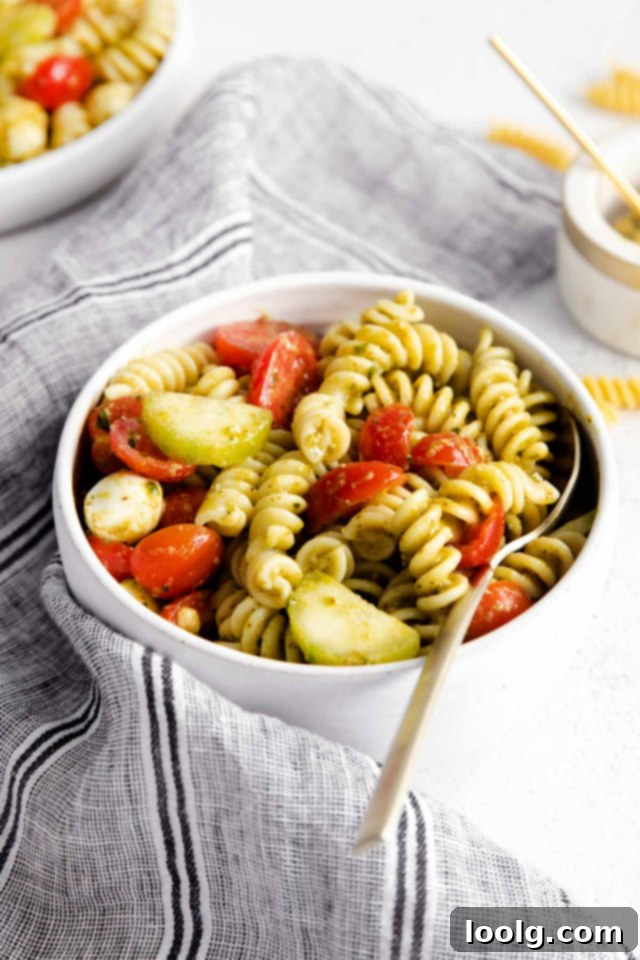
Freezing Pesto Pasta Salad: A Word of Caution
While the question “Can I freeze it?” might arise for convenience, the real question is, “Should you?” When it comes to freezing an assembled pesto pasta salad, my advice would be to proceed with caution, and generally, I would not recommend it for optimal texture and flavor.
I’ve encountered recipes that suggest freezing the entire salad in a freezer bag and thawing it overnight in the fridge. However, in my experience, frozen pasta, like many other dishes, rarely retains its original quality. Cooked pasta tends to become squishy or mushy after thawing, losing that desirable al dente bite that makes pasta dishes so enjoyable. The fresh vegetables like cherry tomatoes and cucumber also suffer texturally, becoming watery and less crisp upon defrosting.
My strong suggestion for meal prep or long-term storage is to freeze the pesto by itself. As mentioned earlier, homemade pesto freezes wonderfully. When you’re ready to enjoy the pasta salad, simply thaw your pesto in the refrigerator, cook fresh pasta, and then combine all the ingredients as usual. This method ensures you always have a vibrant, delicious, and perfectly textured summer pesto pasta salad.
Hot or Cold: What’s the Best Way to Enjoy Pesto Pasta?
When it comes to pesto pasta, the traditional and often preferred method of enjoyment, especially for this summer salad, is definitely cold or served at room temperature. The reason for this preference is rooted in how heat affects fresh pesto.
Heating pesto can alter its vibrant color, causing the fresh basil to darken and lose some of its bright green hue. More importantly, high heat can diminish the fresh, aromatic qualities of the basil and olive oil, sometimes making the pesto taste less lively or even slightly bitter. The goal of pesto is to celebrate the raw, fresh flavors of its ingredients.
However, if you are set on having a warm pesto pasta, there’s a way to do it without completely sacrificing the pesto’s integrity. The trick is to combine the pesto with freshly cooked, still-warm pasta. The residual heat from the pasta will gently warm the pesto just enough to release its aromas without truly cooking it. This allows the pesto to retain its fresh taste and color, providing a delightful warm dish without the downsides of direct heating.
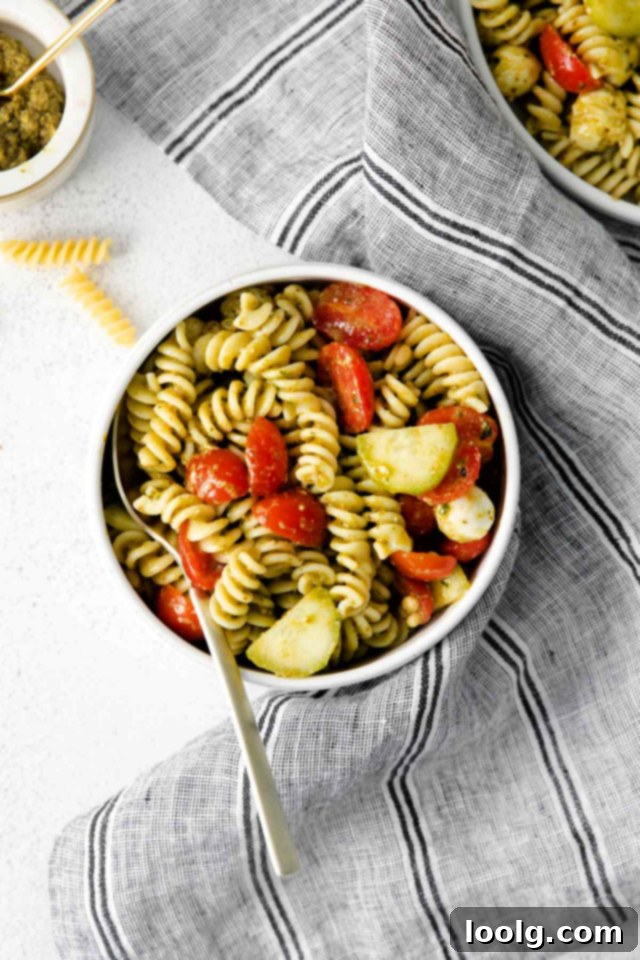
Is Pesto Healthy? Unpacking its Nutritional Benefits
Why, yes, pesto can absolutely be a healthy addition to your diet! Like most delicious foods, moderation is key, but pesto offers a surprising array of nutritional benefits, especially when made with fresh, quality ingredients.
Let’s break down some of its wholesome components:
- Protein Power: You might be surprised to learn that a single serving of pesto can provide around 3 grams of protein, primarily from the pine nuts and Parmesan cheese.
- Minerals Galore: Pesto is a good source of important minerals such as calcium (from the cheese), iron, and potassium, contributing to bone health, oxygen transport, and electrolyte balance, respectively.
- Vitamins and Antioxidants:
- Basil: The star herb is rich in Vitamin C, a powerful antioxidant vital for immune function and skin health, as well as Vitamin K, important for blood clotting and bone health.
- Extra Virgin Olive Oil: This healthy fat is loaded with Vitamin E, another potent antioxidant that protects cells from damage. It also contains anti-inflammatory compounds, which can contribute to overall heart health.
- Pine Nuts: Beyond their protein content, pine nuts offer healthy fats, fiber, and magnesium.
Overall, pesto is a nutrient-dense sauce, rich in healthy fats, vitamins, minerals, and beneficial antioxidants. It’s a wholesome and nutritious addition to your diet, elevating both flavor and healthfulness in your meals. For an even lighter summer pasta option, consider this refreshing Summer Squash Pasta Salad!
Making Your Pesto Pasta Salad Gluten-Free
Absolutely! Adapting this delicious summer pesto pasta salad to be gluten-free is incredibly easy, requiring just two simple swaps: choosing gluten-free pasta and ensuring your pesto sauce is also gluten-free.
You might instinctively think, “Isn’t pesto naturally gluten-free?” And you’d be largely right, as traditional pesto recipes don’t typically contain gluten-containing ingredients. It’s usually made from basil, pine nuts, garlic, Parmesan cheese, and olive oil, all of which are naturally gluten-free. However, the answer can be more complex when it comes to store-bought brands.
Some commercially produced pestos might contain tricky additives or be subject to cross-contamination during manufacturing, making them unsuitable for those with celiac disease or severe gluten sensitivities. Therefore, if you are extremely sensitive to gluten, it’s crucial to select a store-bought pesto that is explicitly labeled and certified gluten-free. Alternatively, making your own pesto from scratch ensures you know exactly what ingredients are going into your sauce, giving you complete control over its gluten-free status.
Finding gluten-free pasta is also much easier than it used to be. Most major grocery chains now carry a wide selection. Look for pastas made from corn, rice, quinoa, or legumes. If you can’t find a dedicated “gluten-free” section, check the pasta aisle carefully for specific labels or inquire at customer service. With these two simple adjustments, everyone can enjoy this delightful summer dish!
What to Serve with This Versatile Pesto Pasta Salad
This summer pesto pasta salad is incredibly versatile, making it an excellent companion for a variety of main dishes. Whether you’re serving it as a light lunch, a vibrant side salad, or a protein-packed main course, there’s a perfect pairing for every occasion.
Grilled Favorites: As a side salad, it beautifully complements any grilled meat. The fresh, herbaceous notes of the pesto cut through the richness of grilled steak, pork chops, or chicken, creating a balanced and satisfying meal. Think of it as the ultimate BBQ sidekick.
- Italian Appetizers: Start your meal with another Italian classic like Mozzarella Bruschetta! You already have mozzarella and fresh flavors, making this a perfect and convenient appetizer pairing.
- Complementary Salads: If you’re looking to serve more greens, this pasta dish pairs wonderfully with other fresh salads:
- Panzanella Salad: A Tuscan-style bread salad that’s hearty, full of fresh vegetables, and satisfying.
- Italian Tomato Salad: Super easy and fresh, this simple salad highlights juicy tomatoes, perfectly echoing the flavors in your pesto pasta.
- Main Course Poultry:
- For a smoky flavor, try it alongside Smoked Chicken Quarters. The rich, smoky notes are a fantastic contrast to the bright pesto.
- If you prefer using the oven, this Chicken Leg Quarters Recipe offers a delicious and easy baked option.
- Sweet Endings: Conclude your delightful summer meal with a light yet decadent dessert. This Italian Lemon Almond Flour Cake (Torta Caprese Bianca) would provide a wonderfully citrusy and sweet finish.
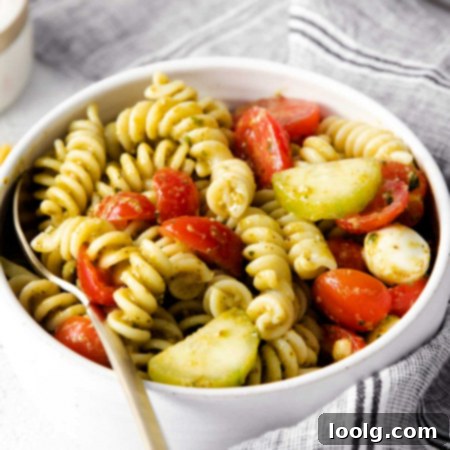
Summer Pesto Pasta Salad
Ingredients
- 16 ounces (450 grams) fusilli pasta (use gluten-free pasta for a GF version)
- ¾ cup (185 grams) basil pesto
- 2 cups (300 grams) cherry tomatoes halved
- 8 ounces (225 grams) mini mozzarella pearls
- 1 medium cucumber peeled and sliced
- ¼ cup (35 grams) toasted pine nuts
- Salt and pepper to taste
Instructions
-
Cook the pasta according to the package instructions, reserving 1 cup of the pasta water before you drain the water
-
Rinse the pasta with cool water.
-
In a large bowl, mix together 1/4 cup reserved pasta water with the pesto.
-
Add the pasta, tomatoes, mozzarella, cucumber and pine nuts and mix until combined.
-
Add salt and pepper.
-
Serve chilled or at room temperature.
-
Refrigerate in an airtight container for up to 3 days.
Notes
- The best ingredients will give you the best results, so get the best-tasting pesto if you’re using store-bought and use the freshest ingredients if making your own pesto sauce.
- Rinsing the pasta under cool water stops the cooking process, so you have perfectly cooked al dente pasta. Otherwise, it could turn mushy.
Here’s to eating well and making delicious memories with #easywholesome recipes! If you whip up this incredible Summer Pesto Pasta Salad, be sure to leave a comment below and let me know what you think. Happy summer and happy cooking, everyone!
